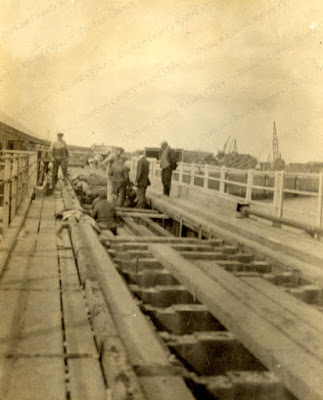St George’s Day, 23 April, is a significant date for George Nicholson Bradford. Born on that day in 1887, George was the second of the four Bradford brothers who served in the First World War. On the same day in 1918, George, a Lieutenant Commander in Royal Navy, was killed in action off the coast of Zeebrugge, Belgium. For his actions on St George’s Day 1918, he was posthumously awarded the Victoria Cross (VC).This is County Durham’s only First World War naval VC.
 |
| A view of the wreck of HMS Intrepid taken at Zeebrugge, April 1920 (D/DLI 7/602/8(16)) |
In April 1918, a plan was formed to raid the port of Zeebrugge and block the canal to Bruges, in order to prevent German vessels from leaving.
The plan was audacious and dependent on taking the heavy enemy defences completely by surprise. Three block ships were to be sailed into the mouth of the canal connecting Zeebrugge and Bruges and sunk. To allow the block ships to sail into position unobserved, a raiding force of Marine Light Infantry and 200 Royal Naval Blue Jackets would land on the mole to create a diversion. Other diversions included two submarines ramming and destroying a bridge on the mole [massive stone breakwater], naval bombardment from the sea, and air attacks on the town of Zeebrugge.
George Bradford was selected to lead the Blue Jacket contingent, taking command of a requisitioned Mersey ferry, HMS Iris II. After two delayed starts, the weather and tide was in their favour, until the last moment, as the raiders neared the coast. The wind changed direction and blew the smoke screen out to sea, revealing their positions to the enemy. In the scramble, under fire from the enemy, to get the ships into position, the sailing conditions became difficult.
 |
| A view of the Zeebrugge mole, April 1920 (D/DLI 7/602/8(14)) |
George Bradford’s Victoria Cross citation details his actions:
“Though securing the ship was not part of his duties, Lieutenant Commander Bradford climbed up the derrick, which carried a large parapet anchor and was rigged out over the port side; during this climb the ship was surging up and down and the derrick crashing on the Mole; waiting his opportunity he jumped with the parapet anchor on to the Mole and placed it in position. Immediately after hooking on the parapet anchor Lieutenant Commander Bradford was riddled with bullets from machine guns and fell into the sea between the Mole and the ship. Attempts to recover his body failed. Lieutenant Commander Bradford’s action was one of absolute self-sacrifice; without a moment’s hesitation he went to certain death, recognising that in such action lay the only possible chance of securing ‘Iris II’ and enabling her storming parties to land.”
 |
| Commemorative paving stone for George Bradford. © John Attle |
At 11am on Saturday, 21 April 2018, George will be honoured at Witton Park, County Durham, his place of birth. Here, his VC paving stone will be laid in the memorial garden, alongside that of his brother, Roland Boys Bradford (whose stone was laid in March 2017). The stone will be unveiled by the Lord Lieutenant Sue Snowdon, and the ceremony will be attended by members of the family, and representatives of the Royal Navy and the Royal Marines. The service will be jointly led by the chaplains of the Durham Light Infantry, and of the Royal Navy.
A commemoration of the raid will take place in Zeebrugge on the 21 April 2018, and will be attended by military personnel from Britain, Germany, and Belgium. At the end of the ceremony that day, there will be the dedication of a memorial to George Bradford. https://www.royalnavy.mod.uk/news-and-latest-activity/news/2018/march/29/180329-zeebrugge-raid-centenary
You can read more about George Bradford and his full citation on Durham at War:
http://www.durhamatwar.org.uk/story/11171/
http://www.durhamatwar.org.uk/material/493/

No comments:
Post a Comment